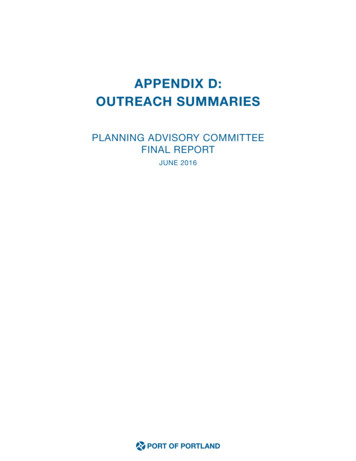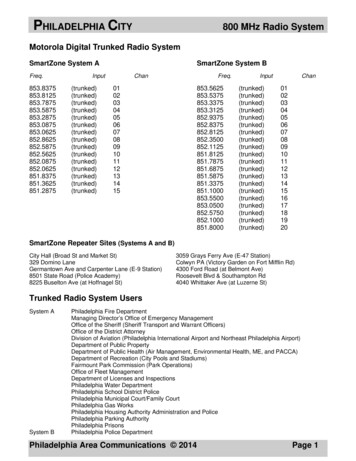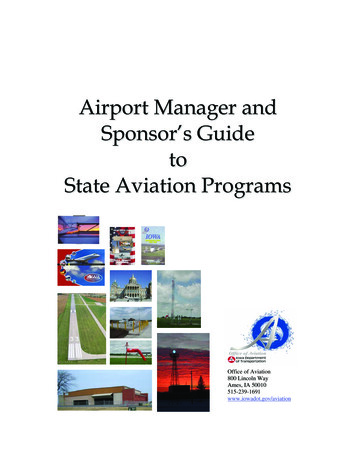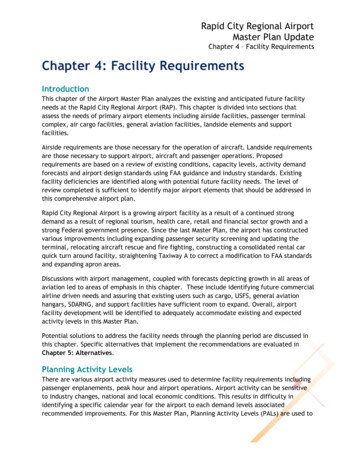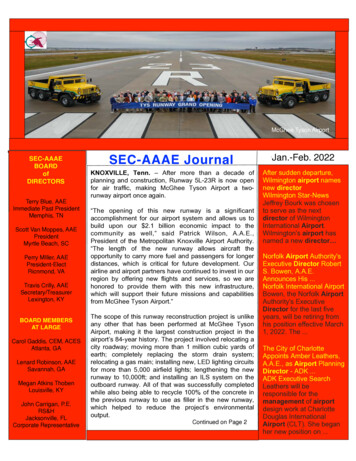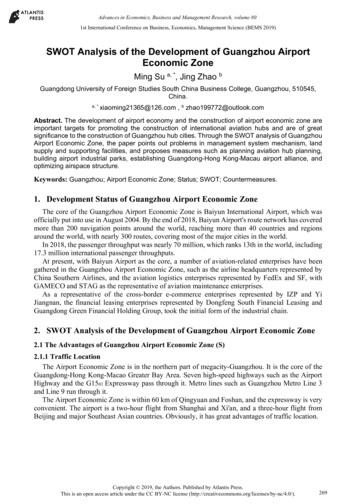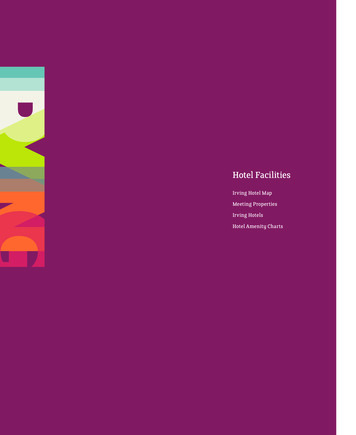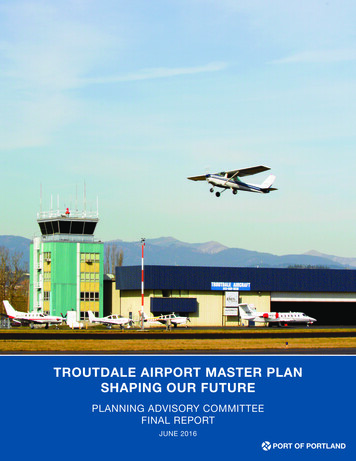
Transcription
TROUTDALE AIRPORT MASTER PLANSHAPING OUR FUTUREPLANNING ADVISORY COMMITTEEFINAL REPORTJUNE 2016
May 11, 2016Port of Portland Executive Director,Troutdale Airport: Shaping Our Future was a complete airport master plan process that went above and beyond.While the master plan followed many of the traditional steps characteristic of an airport master plan, it also exploreda broader range of issues important to the Port, City and greater region. Before the process began, the Port ofPortland recognized that Troutdale Airport was a valued community asset on an unsustainable path. At the sametime, the Port identified a local community need for increased economic opportunities. This master plan processwas exceptional in that it not only addressed the airport resources required to continue serving aviation needs,it also evaluated how Troutdale Airport could sustainably serve local community needs as a whole for the next20 years.The Port of Portland invited a group of 23 stakeholders – representing diverse values of economic, environmentaland social sustainability – to create a project advisory committee (PAC) charged with providing input andrecommendations for the master plan process. From the spring of 2014 to the spring of 2016, I worked with theseoutstanding individuals and the Port to develop our recommendations on the Troutdale Airport Master Plan. As aPAC, we were given the opportunity to provide input on planning documents and engage in rigorous discussionabout Troutdale Airport’s role in the future. Our recommendations were also informed by community input collectedfrom stakeholder meetings and public involvement activities prior to key project milestones.This report provides a summary of the Troutdale Airport: Shaping Our Future process. It contains summaries of our11 PAC meetings with an abridged narrative of our work, highlights from the resulting master plan document andour proposal to continue communication with the Port as the plan is implemented. At the end of the report you willfind our PAC recommendations outlined as follows: The Port include Alternative C with a 4,500-foot runway and 56 acres of industrial development on theAirport Layout Plan submitted to the Federal Aviation Administration for review and acceptance in 2015 The Port continue to manage TTD as an important part of the regional and state airport system withphased implementation of Alternative C The Port and City of Troutdale work with other east county interests as appropriate to maintain andenhance TTD’s viability as an important part of the Portland airport system, and support both the aviationand industrial goals of the communityThe PAC would like to thank the Port of Portland and the many involved stakeholders for taking the time toparticipate in this important community engagement process. We also thank the consultants for providing thedetailed technical and policy analysis required to develop our recommendations. We look forward to watchingTroutdale Airport thrive with our community in its future role.Respectfully submitted,Travis Stovall, PAC Chair
TABLE OF CONTENTSExecutive Summary.7I.Background.12A. Context. 12B. History. 12C. Purpose and Assumptions. 13D. Sustainability. 14E. Planning Advisory Committee. 15F. Analytical Framework. 16II. Public Involvement andStakeholder Outreach.17A. Public Involvement. 17B. Stakeholder Outreach. 17C. Project Website. 18III. Planning AdvisoryCommittee Meetings.19PAC Meeting #1. 19PAC Meeting #2. 21PAC Meeting #3. 24PAC Meeting #4. 28PAC Meeting #5. 30PAC Meeting #6. 33PAC Meeting #7. 38Special Topics Meeting. 43PAC Meeting #8. 46PAC Meeting #9. 53PAC Meeting #10. 56PAC Meeting #11. 594IV. TROUTDALE AIRPORT MASTERPLAN HIGHLIGHTS.62A. Existing Conditions: Airport Inventory. 62B. Existing Conditions: Land Use Inventory. 63C. Aviation Activity Forecast. 64D. Land Use Demand Forecast. 66E. Airport Role Analysis. 68F. Preliminary Alternatives, EvaluationCategories and Decision Making Matrix. 69G. Facility Requirements, Refined Alternativesand Analysis. 70H. Preferred Airport Alternative. 72I. Implementation Plan. 74J. Airport Layout Plan. 76V. Conclusion and Recommendations.77Appendices Table of Contents.80Glossary of Key Terms.80
ACKNOWLEDGEMENTSPlanning Advisory CommitteeVoting MembersTravis Stovall, ChairChris Berg, Hillsboro Aero AcademyMark Brown, Northwest AeroMark Clark, City of Wood VillageClaude Cruz, West Columbia Gorge Chamberof CommerceChris Damgen, City of TroutdaleErika Fitzgerald, City of GreshamAlternates/Previous MembersBruce Fisher, Federal Aviation AdministrationSteve Gaschler, City of TroutdaleJon Hay, Hillsboro Aero AcademyKirsten Pennington, Oregon Departmentof TransportationCasey Ryan, Gresham Chamber ofCommerce / FinanceSunny Simpkins, Multnomah County Drainage DistrictRian Windsheimer, Oregon Departmentof TransportationBob Fowler, Toyo TansoBarb Jones, Fairview NeighborhoodTechnical ResourcesBobby Lee, Oregon Governor’s RegionalSolutions TeamBob Akers, 40 Mile Loop Land TrustBrian Lessler, Gresham Chamber of CommerceRon George, U.S. Forest Service, Mount Hood AirTanker BaseKatherine McQuillan, Multnomah CountyErika Palmer, City of FairviewHeather Peck, Oregon Department of AviationDoug Daoust, Troutdale MayorDeborah Roy, U.S. Forest Service, Fire ServiceManager Gifford Pinchot National ForestJim Rodrigues, ProLogisJoel Schoening, Multnomah County Drainage DistrictProject Team Port of PortlandJoe Smith, Oregon Pilots AssociationKenneth AndertonAlan Snook, Oregon Department of TransportationScott DrummJose Villalpando, At-Large Community MemberJason GatelySteve Wise, Sandy River Basin Watershed CouncilLise GlancyMarvin Woidyla, Gorge Winds AviationWendy HainMarla HarrisonNon-Voting MembersDerek JaegerSteve Nagy, Port of PortlandSean LoughranJason Ritchie, Federal Aviation AdministrationSteve NagyRob SchultzPhil StenstromChris White5
ACKNOWLEDGEMENTSProject ConsultantsFor more information, please contactSeth Baker, EnviroIssuesSean LoughranMitchell Hooper, Mead and HuntPort of PortlandSam Imperati, Institute for Conflict Management7200 NE Airport WaySteve Schreiber, JviationPortland, OR 97218Damon Smith, Mead and chnical Project ConsultantsDavid Benner, Aviation Management Consulting GroupJason GatelyBrandon Borne, Aviation ManagementConsulting GroupPort of PortlandSarah Hartung, Environmental Science AssociatesPortland, OR 97218Jerry Johnson, Johnson Economics503-415-6570Todd Johnson, Mackenzie EngineeringJason.Gately@portofportland.com7200 NE Airport WayJeff Kohlman, Aviation Management Consulting GroupMark McFarland, McFarland ArchitectsProject websiteDavid Miller, Century West Troutdale/MasterPlanSamantha Peterson, Century West EngineersMaureen Raad, Environmental Science AssociatesShayna Rehberg, Angelo Planning GroupMatt Rogers, Century West EngineersDarci Rudzinski, Angelo Planning GroupBob Thompson, Mackenzie EngineeringBrian Varricchione, Mackenzie EngineeringKen Vigil, Environmental Science Associates6How to read this documentFor a general overview of the process and keyrecommendations, please read the ExecutiveSummary. For more detail, please read the bodyof this report.
EXECUTIVE SUMMARYThrough the nearly two-year planning process, a planemerged guided by triple-bottom line sustainabilitygoals that balanced economic, environmental andsocial interests, and considered seven evaluationcategories identified by the PAC. The evaluationcategories included: Alignment with forecasts Community economic benefits Community planning compatibility Environmental impactsIntroductionIn 2014, the Port of Portland (Port) initiated an updateto the Troutdale Airport Master Plan called, TroutdaleAirport: Shaping Our Future. The Master Plan providesa roadmap for the development, operation andinvestment at Troutdale Airport (TTD or the Airport)over the next 20 years. This study was designed toassist the Port in determining what role the 261-acreTroutdale Airport will play in meeting the Port’s missionto enhance the region’s economy and quality of lifeby providing efficient cargo and air passenger accessto national and global markets, and by promotingindustrial development. In order to determine the futurerole of the Airport, Port management required a deeperunderstanding of the complex relationship betweenaviation uses at TTD and other nearby airports(especially Portland International Airport) and thesurrounding land uses, both current and projected. Financial impacts Fit with local airport system Legal feasibilityThe PAC considered four development alternativesthat proposed different answers to the central questionof the planning process: “What is the role of theTroutdale Airport in the future?” PAC members workedwith the project team to complete an initial evaluationof each alternative. The four preliminary developmentalternatives considered are listed on the next page.To support this planning process, the Port establisheda Troutdale Airport Planning Advisory Committee (PAC)made up of 23 members to help the Port assessthe future and recommend an optimal role for theAirport over the next 20 years. The PAC membershiprepresented a broad range of community, government,and commercial interests. Two members of the PACwere non-voting ex officio members representing thePort of Portland and Federal Aviation Administration.PAC engagement was supplemented with additionalpublic input at key milestones, documented in SectionII Public Involvement and Stakeholder Outreach.7
Development AlternativesAlternative A:Maximum Commercial/IndustrialClose Troutdale AirportConvert all available land for commercial/industrial usesAlternative B:More Commercial/Industrial, Less AviationReduce and consolidate aviation land to create space for commercial/industrial usesRetain flight training, recreational and maintenance and repair aviation usesLess accommodation for large business jets compared to Alternative CAlternative C:Less Commercial/Industrial, More AviationReduce and consolidate aviation land to create space for commercial/industrial usesRetain flight training, recreational and maintenance and repair aviation usesMore accommodation for large business jets compared to Alternative BAlternative D:Maximum AviationExpand Troutdale AirportRetain flight training, recreational and maintenance and repair aviation usesIncrease accommodation for large business jetsAs a result of this evaluation, a majority of the PACinitially identified two alternatives that best addressedthe sustainability goal and the seven PAC evaluationcategories. Both Alterative B and Alternative Ccontinue TTD’s role as a general aviation airport andaccommodate approximately 99 percent of the currentand future TTD aviation operations. While the PACcontinued to consider all alternatives until the end ofthe process, the PAC voted and directed the projectteam to focus their refined analysis on Alternative Band Alternative C.Refined Alternative B:3,600-foot long and 75-foot wide runway. Runwaylength in Alternative B is determined by the criticaldesign aircraft (Beechcraft King Air). Aviation activitiesrelocated to the south side of the Airport with 56acres on the north side of the Airport redeveloped forindustrial/commercial use and an additional 20 acresat the far west end of the Airport reserved for futureindustrial or commercial use.8Refined Alternative C:4,500-foot long and 75-foot wide runway. Runwaylength is determined by the existing roadways atthe east and west end of the Airport (Graham Road,Sundial Road and Marine Drive). Aviation activitiesrelocated to the south side of the Airport with 56acres on the north side of the Airport redeveloped forindustrial/commercial use.In discussions with the PAC and in balancingsustainability goals, the Port leadership team indicateda preference for Alternative B. This was based oninterest in matching TTD facilities with the forecastaviation demand and the regional aviation system,limiting infrastructure demands and impacts on theenvironment, supporting jobs and economic benefitsin the region and addressing the longstanding financialchallenges associated with TTD.The PAC understands the financial challengesassociated with TTD and the value of an appropriateand financially efficient airport facility. The Airport hasoperated at a loss since the Port acquired it in 1942(revenue compared to expenses), and is projectedto do so for the foreseeable future, unless significantchanges are made to revenues and expenses.The runway and taxiway infrastructure requiresreconstruction and these updates are expensiveand will draw upon limited Port and FAA funds. ThePAC recognizes that the Port has underwritten TTDoperations with PDX Aviation Funds and that privateinvestment in TTD has been limited during the last20 years.
Preferred AlternativeOn March 16, 2016, the PAC voted by majorityto recommend Alternative C. Prior to the vote,four members noted potential modifications to therecommendation: 1) accommodate 100 percent ofaviation activity, 2) use available time before runwayreconstruction to seek other funding for the currentrunway length, but acknowledge funding may not beavailable, 3) include an effort to reduce TTD’s approachceiling to 800 feet and 4) preserve the ability for theAirport to expand.After discussion, the 19 voting members who werepresent (two members were absent) submitted theirvotes. Fifteen members voted a “1,” meaning they fullysupported the recommendation without modification.Three members voted a “2,” meaning they agreed withthe recommendation but preferred to have it modifiedin order to give it full support. Nevertheless, themembers support the recommendation. One membervoted a “2 ,” which is short of a “3.” A “3” means arefusal to support the recommendation. There is noprovision for a “2 ” vote in the Collaboration Principles(see Appendix A). However, the “2 ” was considereda “3.” When there is a majority-minority vote, membersvoting a “1” or a “2” favor the proposal and membersvoting a “3” oppose the proposal, which means theend result was 18 PAC members in favor and one PACmember against.During the final PAC meeting on April 27, 2016, twoPAC members changed their vote on the preferredalternative from a “2” to a “3.” The end result is 16PAC members in favor of Alternative C and three PACmembers against.PAC Vote Summary on TTD Master PlanAlternative C RecommendationAbsent2Non-voting ex officio members2Full support of recommendation (“1”)15Support recommendation withmodification (“2”)1Do not support recommendation (“3”)3Total PAC members23PAC Vote by Member on TTD MasterPlan Alternative C RecommendationVoting MembersVoteTravis Stovall, Chair“1”Chris Berg, Hillsboro Aero Academy“1”Mark Brown, Northwest Aero“1”Mark Clark, City of Wood Village“3”Claude Cruz, West Columbia Gorge Chamberof Commerce“1”Chris Damgen, City of Troutdale“1”Erika Fitzgerald, City of Gresham“1”Bob Fowler, Toyo Tanso“1”Barb Jones, Fairview Neighborhood“1”Bobby Lee, Oregon Governor’s RegionalSolutions Team“1”Brian Lessler, Gresham Chamberof CommerceAbsentKatherine McQuillan, Multnomah County“1”Erika Palmer, City of Fairview“1”Heather Peck, Oregon Departmentof Aviation“2”Jim Rodrigues, ProLogisAbsentJoel Schoening, Multnomah CountyDrainage District“1”Joe Smith, Oregon Pilots Association“3”Alan Snook, Oregon Department ofTransportation“1”Jose Villalpando, At-LargeCommunity Member“1”Steve Wise, Sandy River BasinWatershed Council“1”Marvin Woidyla, Gorge Winds Aviation“3”Non-Voting MembersSteve Nagy, Port of PortlandN/AJason Ritchie, Federal AviationAdministrationN/A9
While recognizing that Alternative B best addressesTTD’s financial sustainability challenges, the PACrecommended by majority vote Alternative C tomaintain maximum flexibility for increased aviationdevelopment at TTD. In making this recommendation,the PAC recognizes that jobs and private sectorinvestment is critical to reversing the disadvantagedeconomic demographics of east Multnomah Countywhile providing the tax base for public services, andbelieves that both Troutdale Reynolds Industrial Park(TRIP) and TTD can play a role in that vision. Further,the PAC recognizes that managing TTD costs andsecuring new private investment is essential to theongoing success of the Airport, and requires an activepartnership between the community and the Port inachieving this community vision. The PAC understandsthat the Port will undertake another master planningprocess within about 10 years and will again considerthe role of the Airport in light of the progress madetoward financial sustainability.Recommendations from the PAC –Majority VoteThe Troutdale Airport PAC recommends that the Portof Portland’s Executive Director accept the PAC Reportand the following recommendations:1. Accept the TTD Master Plan with AlternativeC as the preferred alternative in which theTTD Master Plan would reflect a 4,500-footby 75-foot runway and 56 acres of industrialdevelopment on the Airport.2. Request Port Commission approval to submitthe TTD Master Plan, showing an AirportLayout Plan consistent with Alternative C tothe Federal Aviation Administration (FAA) forreview and acceptance.3. The Port continue to manage TTD as animportant part of the regional and stateairport system with phased implementation ofAlternative C.4. The Port work with tenants on the northside of TTD to allow transition of theirbusiness plans to align with implementationof Alternative C and to retain the vibrancy ofTTD as a regional asset. The transition will becoordinated with tenant lease expirations.105. The Port continue to monitor aviation issuesand trends, and adapt TTD plans accordinglyto meet changing industry needs.6. The Port dedicate revenues from TTDindustrial property leases on the north of theAirport and aviation development on the southside of the Airport to enhance the financialsustainability of the Airport.7. The Oregon Department of Aviation andFAA support investments to help maintainTTD infrastructure and operations, includingrunway rehabilitation. The Port will keep TTDtenants updated on construction impactsrelated to the runway rehabilitation.8. The Port and City of Troutdale work with othereast Multnomah County interests (i.e., EastMetro Economic Alliance, West ColumbiaGorge Chamber of Commerce, MultnomahCounty, Gresham Chamber of Commerce,east county cities and other stakeholders asappropriate) to maintain and enhance TTD’sviability as an important part of the Portlandairport system, and support both the aviationand industrial goals of the community.a. The Port continue its efforts to supportexisting and future TTD tenants (e.g., FixedBased Operations, flight training), provideaviation market rate lease terms/ratesat TTD and market TTD for aviation andindustrial uses and compatible industrialuses at TRIP.b. The City of Troutdale commit to identifyways to assist the Port of Portland tofurther market and incent development atTTD and TRIP.
c. To support this partnership, the Portand City enter into an intergovernmentalagreement which identifies ways to realizethe aviation and industrial goals related toTTD and TRIP and defines benchmarks formeasuring progress.i. Benchmarks may include but notbe limited to: growth in number ofTTD tenants, number of TTD aircraftoperations, amount of new privatecapital investment, TTD revenuesversus expenses; TTD financialsustainability.On April 27, 2016 the PAC voted unanimously toapprove the draft PAC Report and authorized the PACChair to approve any final substantive edits made afterthat date. The PAC Chair approved this final report onMay 11, 2016.Minority OpinionsPAC members were given the opportunity to includeminority reports with this document. One minorityreport was submitted and is included in Appendix E.ii. Where available, the baseline forbenchmark tracking will be the forecastand financial information included inthe 2014-16 TTD Master Plan process.iii. The goal is to realize an improvementin the revenue versus expensebenchmark from the baselinemeasure annually.d. The Port and City of Troutdale providean annual report to review progress ontheir collective work toward benchmarksin support of TTD aviation and industrialdevelopment as well as TRIP industrialdevelopment. The Port and City ofTroutdale will notify involved stakeholderswhen annual reports are available andpresent report findings in a public forum.9. Finally, the PAC recommends that as part ofthe next master plan update (expected to becompleted in approximately 10 years) thatthe Port plan to evaluate progress towardTTD financial sustainability with the goal ofclosing the gap in revenues versus expenses.If TTD continues to operate at a deficit afterthis good faith effort, the PAC understandsthat the Port will need to reevaluatealternatives consistent with the goal offinancial sustainability.11
I. BACKGROUNDA. ContextB. HistoryTroutdale Airport (TTD or the Airport) is a generalaviation airport located within the city of Troutdalenorth of I-84 near the confluence of the Sandy andColumbia rivers. TTD is one of three airports ownedand operated by the Port of Portland (Port) in a systemthat also includes Portland International Airport (PDX)and Hillsboro Airport (HIO). TTD and PDX are eightnautical miles apart, placing TTD’s Class D airspacewithin the Class C airspace of PDX.Troutdale Airport has served many roles as demandfor aviation has changed over time. The Airport beganas a private airfield in 1920 and was purchased bythe Port in 1942 as part of a plan to develop a systemof airports to meet growing demand for commercialand general aviation. Since that time, TTD has serveda variety of roles, including emergency responseoperations, flight training schools and recreationalaviation, as well as business aviation activities.TTD property includes approximately 261 acresgenerally bounded by Graham Road to the north,Sundial Road to the west, Frontage Road to the southand the Sandy River to the east. The north side of TTDis adjacent to the former site of the Reynolds Metalsaluminum smelter, which was acquired by the Portand redeveloped as the Troutdale Reynolds IndustrialPark (TRIP) in 2007. The Columbia River GorgeNational Scenic Area begins on the east side of theSandy River. The Airport is located within a managedfloodplain protected by a system of levees along theSandy and Columbia rivers.Aviation activity decreased nation-wide, including atTTD, following the economic recession in 2008 andhas slowly recovered over time. A helicopter flighttraining school opened at TTD in 2012, contributingto a significant increase in airport operations. In 2014,flight training operations contributed about 50 percentof all operations at TTD. This upward trend is expectedto continue.It is the Port’s goal for all of its airports to besustainable from an economic, environmental andsocial perspective. However, TTD faces significantfinancial challenges. It takes a substantial amount ofresources to operate and maintain the Airport andTTD’s expenses exceed its revenues. The Airport hasoperated at a net loss since the Port acquired it in1942, losing between 500,000 and 1 million peryear. For decades, the Port has supported operationsat TTD using revenue generated at PDX. While aviationactivity has increased in recent years, it has notmade TTD profitable. This negative financial trend isprojected to continue if nothing changes.Adding to this challenge is the fact that TTD’srunway and taxiway infrastructure is in need of fullreconstruction. Private investment has been limitedat TTD in recent decades, requiring the use of finitecapital funds from the Port of Portland and FederalAviation Administration (FAA).Map 1 Airport Location produced by Mead and Hunt12
Figure 1 Project RoadmapC. Purpose and AssumptionsThe Troutdale Airport Master Plan (Master Plan) willprovide a roadmap for the development, operationand investment at TTD over the next 20 years. Thisstudy will assist the Port in determining what rolethe 261-acre Troutdale Airport will play in meetingthe Port’s mission to enhance the region’s economyand quality of life by providing efficient cargo and airpassenger access to national and global markets, andby promoting industrial development. A typical airportmaster plan includes several planning documents thatassess the level of use expected at the airport andthe facilities required to accommodate those uses.The Troutdale Airport Master Plan addresses thisassessment in the following components: Inventory of facilitiesHowever, the scope of this master plan goes beyondwhat is typical for an airport master plan. This planningprocess began at a time when the runway and taxiwaysystem at TTD was reaching the end of its usefullife. Before spending significant financial resourcesfrom limited Port and FAA funds to reconstruct thesefacilities, the Port decided to conduct a broadermaster plan process to evaluate the role of TroutdaleAirport within the local community and regional airportsystem. A primary goal of the Master Plan was tocollect input from community members to understandwhat they value about the Airport and how theyenvision using it for the foreseeable future. As such,the Port broadened the scope of the planning processto include alternative uses for TTD property that couldprovide community benefits and make the Airportmore sustainable. Twenty-year demand forecast ofaviation activity Documentation of facility requirements Evaluation of alternatives Selection of a preferred alternative Capital Improvement Plan Airport Layout Plan13
The Port of Portland convened the Troutdale AirportPlanning Advisory Committee (PAC) to representstakeholders from a broad range of interests that couldbe affected by changes at TTD. The purpose of thePAC was to provide input at key milestones in theplanning process and develop recommendations thatanswer the following questions.What is the role of Troutdale Airport in the future? What markets is the Airport best suitedto serve? Are there legal constraints that impact futureoperations? Are there environmental constraints thatimpact future operations? What are the primary development options? What are the financial impacts ofthese options? What is the community economic benefit ofthese options? How does the community feel aboutthese options? What is the preferred development option torecommend to the Port Executive Director?In addition to reviewing master plan elements, thePAC was asked to consider a range of developmentalternatives that go beyond the scope of a typicalairport master plan. These development alternativesincluded options to develop the Airport’s land forcommercial and industrial uses to address demandfor certain land uses, increase local economic benefitsand contribute to the Airport’s financial health. ThePAC developed a set of evaluation categories basedon the above questions and sustainability principlesto score each alternative, help determine what theAirport’s role should be and identify a preferredalternative recommendation for the Port of Portland’sExecutive Director.This process was designed to be iterative, allowingPAC members the opportunity to provide feedbackand direction at each step before moving to the nextsubject. Several topics were revisited as the PACengaged in discussion about TTD’s future role.14Figure 2 Triple bottom line sustainability conceptD. SustainabilityEarly in the planning process, the PAC agreed toinclude sustainability in its considerations throughthree overlapping “lenses,” which included economic,environmental and social sustainability. The combinedinterests of the PAC members were represented inthese three areas and used to develop the evaluationcategories, which were later used to identify apreferred alternative recommendation (see sectionF below).
E. Planning Advisory CommitteeThe centerpiece of the planning process’s publicinvolvement effort was the PAC. At the outset of theplanning process, the project team met with leadersin the region to seek PAC members who could bring avariety of perspectives to the committee. The PAC wascomposed of 23 members representing community,government and commercial interests from economic,environmental and social perspectives. The PACprovided valuable input to help assess the future andrecommend an optimal role for the Airport over thenext 20 years. The mission of the PAC was to: Support meaningful and collaborative publicdialogue and engagement on TroutdaleAirport-related planning and development
Troutdale Airport Master Plan called, Troutdale Airport: Shaping Our Future. The Master Plan provides a roadmap for the development, operation and investment at Troutdale Airport (TTD or the Airport) over the next 20 years. This study was designed to assist the Port in determining what role the 261-acre Troutdale Airport will play in meeting .
